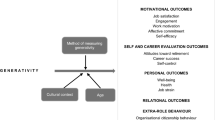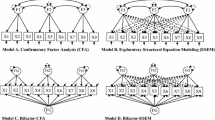Abstract
Given the background of the exploratory studies reported in the previous chapter, the first part of this chapter reports on the confirmation of the WI scale in a different (United Arab Emirates) context, where three work-identity subscales were first extracted from the 28 combined items of the instrument by means of a principal component analysis (PCA). These three subscales (work centrality, person–organisation fit, and value congruence) were then confirmed with a CFA procedure in a structural equation model (SEM). The internal consistency reliabilities (Cronbach Alpha) of the three subscales were, respectively, .92 (14 items), .87 (5 items), and .77 (6 items) for the 25-item scale. In the first part of this chapter where the SEM was tested, it was established that JRs (need for organisational identity (nOID), organisational reputation, task resources, and remuneration perceptions) and JDs (breach of psychological contract and work–family conflict) significantly interacted to predict varying levels of WI which in turn resulted in increased work engagement or turnover intentions.
The second part of this chapter reports on the moderation effects of education levels and nationality groupings. It was found that these moderators have significant effects on paths in the SEM. It was further established that interactions between JRs and JDs significantly affected the level of WI which in turn impacted work engagement and turnover intentions.
Access this chapter
Tax calculation will be finalised at checkout
Purchases are for personal use only
Similar content being viewed by others
References
Bester, F. (2012). A model of work identity in multicultural work settings. Unpublished doctoral thesis, University of Johannesburg, Johannesburg.
Bothma, F. C. (2011). The consequences of employees’ work-based identity. Unpublished doctoral thesis, University of Johannesburg, Johannesburg.
Bothma, F., Roodt, G., & Barkhuizen, N. (2010). Comparing work identity and work engagement as predictors of selected subjective and objective work outcomes. In 27th annual Pan-Pacific conference proceedings (pp. 121–123). Bali: Pan-Pacific Business Association.
Browne, M. W., & Cudeck, R. (1993). Alternative ways of assessing model fit. In K. Bollen & J. S. Long (Eds.), Testing structural equation models (pp. 136–162). Newbury Park: Sage.
Cheney, G. (1983). On the various and changing meanings of organisational membership: A field study of organisational identification. Communication Monographs, 50, 342–362. doi:10.1080/03637758309390174.
De Braine, R. (2012). Predictors of work-based identity. Unpublished doctoral thesis, University of Johannesburg, Johannesburg.
De Braine, R., & Roodt, G. (2011). The job demands-resources model as predictor of work identity and work engagement: A comparative analysis. SA Journal of Industrial Psychology, 37(2), 11 pages. doi:10.4102/sajip.v37i2.88.
Dutton, J., Dukerich, J., & Harquail, C. (1994). Organisational images and member identification. Administrative Science Quarterly, 39, 239–263. doi:10.2307/2393235.
Hair, J. F., Anderson, R. E., Tatham, R. L., & Black, W. C. (1998). Multivariate data analysis (5th ed.). Upper Saddle River: Prentice-Hall International.
Hinkin, T. R. (1998). A brief tutorial on the development of measures for use in Survey Questionnaires. Organizational Research Methods, 1(1), 104–121. doi:10.1177/109442819800100106.
Kanungo, R. (1982). Work alienation: An integrative approach. New York: Praeger.
Kristof, A. L. (1996). Person-organisation fit: An integrative review of its conceptualisations, measurement, and implications. Personnel Psychology, 49, 1–49. doi:10.1111/j.1744-6570.1996.tb01790.x.
Lawler, E., & Hall, D. (1970). Relationship of job characteristics to job involvement, satisfaction, and intrinsic motivation. Journal of Applied Psychology, 54, 305–312. doi:10.1037/h0029692.
O’Reilly, C., Chatman, J., & Caldwell, D. (1991). People and organisational culture: A profile comparison approach to assessing person-organisation fit. Academy of Management Journal, 34, 487–516. doi:10.2307/256404.
Paullay, I., Alliger, G., & Stone-Romero, E. (1994). Construct validation of two instruments designed to measure job involvement and work centrality. Journal of Applied Psychology, 79, 224–228. doi:10.1037/0021-9010.79.2.224.
Piasentin, K., & Chapman, D. (2007). Perceived similarity and complementarity as predictors of subjective person-organisation fit. Journal of Occupational and Organisational Psychology, 80, 341–354. doi:10.1348/096317906X115453.
Pryor, R., & Davies, R. (1989). A comparison of conceptualizations of work centrality. Journal of Organizational Behavior, 10, 283–289. doi:10.1002/job.4030100308.
Author information
Authors and Affiliations
Corresponding author
Editor information
Editors and Affiliations
Appendices
Appendices
1.1 Appendix A: WI Scale Items Grouped According to the Three-Dimensional Structure
WI work centrality (WC) | WI person–organisation fit (POF) | WI value congruence (VC) |
|---|---|---|
1. How much of your identity is based on your occupation? | 17. How personally insulted do you feel when someone criticises the organisation that you work for? | 23. How much does your job allow for the achievement of personal goals? |
2. How much do you see your job as your whole life? | 18. How embarrassed do you feel when the media criticises the organisation that you work for? | 24. How much does your job prevent you from being yourself or becoming who you want to be? |
3. How much is your occupation the most important activity in your life? | 19. How interested are you in what others think about the organisation that you work for? | 25. How rewarding is the work in itself as an activity? |
4. How much do you base the best description of ‘who you are’ on your career? | 20. How much do you think of the organisation’s successes as your own? | 26. We assume your job have high standards. How easily can you identify with the highstandards of your job? |
5. How central does the organisation that you work for stand in your life? | 21. Does it feel like a personal achievement when someone praises the organisation that you work for? | 27. How much are your values the same as the values of the organisation that you work for? |
6. To what extent will your life be valueless without your job? | 28. How much are you able to maintain your own values at the organisation where you work? | |
7. How much is your own identity based on your job? | ||
8. How much do you think of work as the most important aspect of your life? | ||
9. How directly related are all your achievements to your work? | ||
10. How much does your work determine your value as a person? | ||
11. How much is the best description of ‘who you are’ related to the organisation that you work for? | ||
12. How big a part of ‘who you are’ is your work? | ||
14. How much meaning does work add to your life |
Rights and permissions
Copyright information
© 2015 Springer Science+Business Media Dordrecht
About this chapter
Cite this chapter
Bester, F., Bosch, A., Bal, M. (2015). Work-Based Identity Model Testing. In: Jansen, P., Roodt, G. (eds) Conceptualising and Measuring Work Identity. Springer, Dordrecht. https://doi.org/10.1007/978-94-017-9242-4_7
Download citation
DOI: https://doi.org/10.1007/978-94-017-9242-4_7
Published:
Publisher Name: Springer, Dordrecht
Print ISBN: 978-94-017-9241-7
Online ISBN: 978-94-017-9242-4
eBook Packages: Behavioral ScienceBehavioral Science and Psychology (R0)




